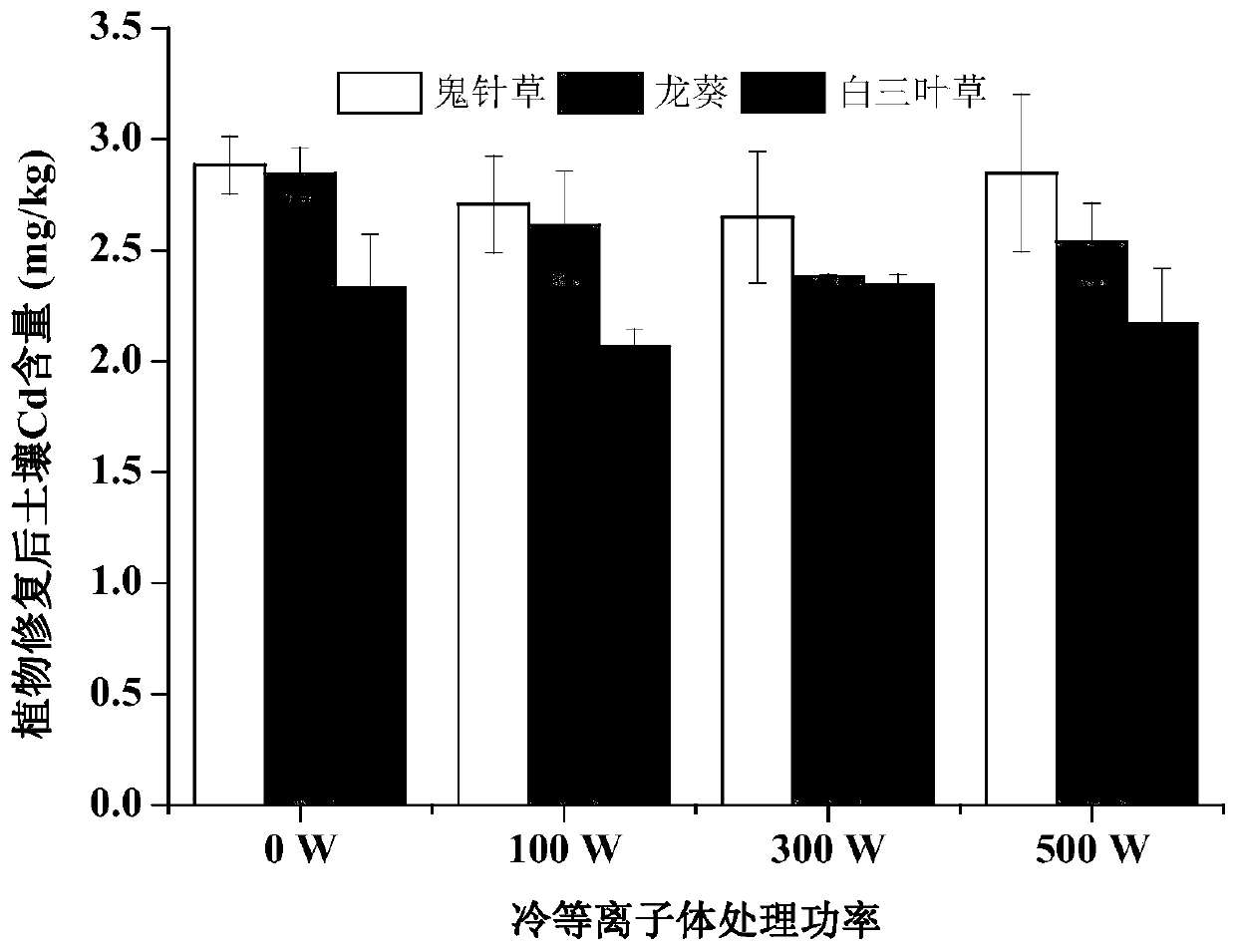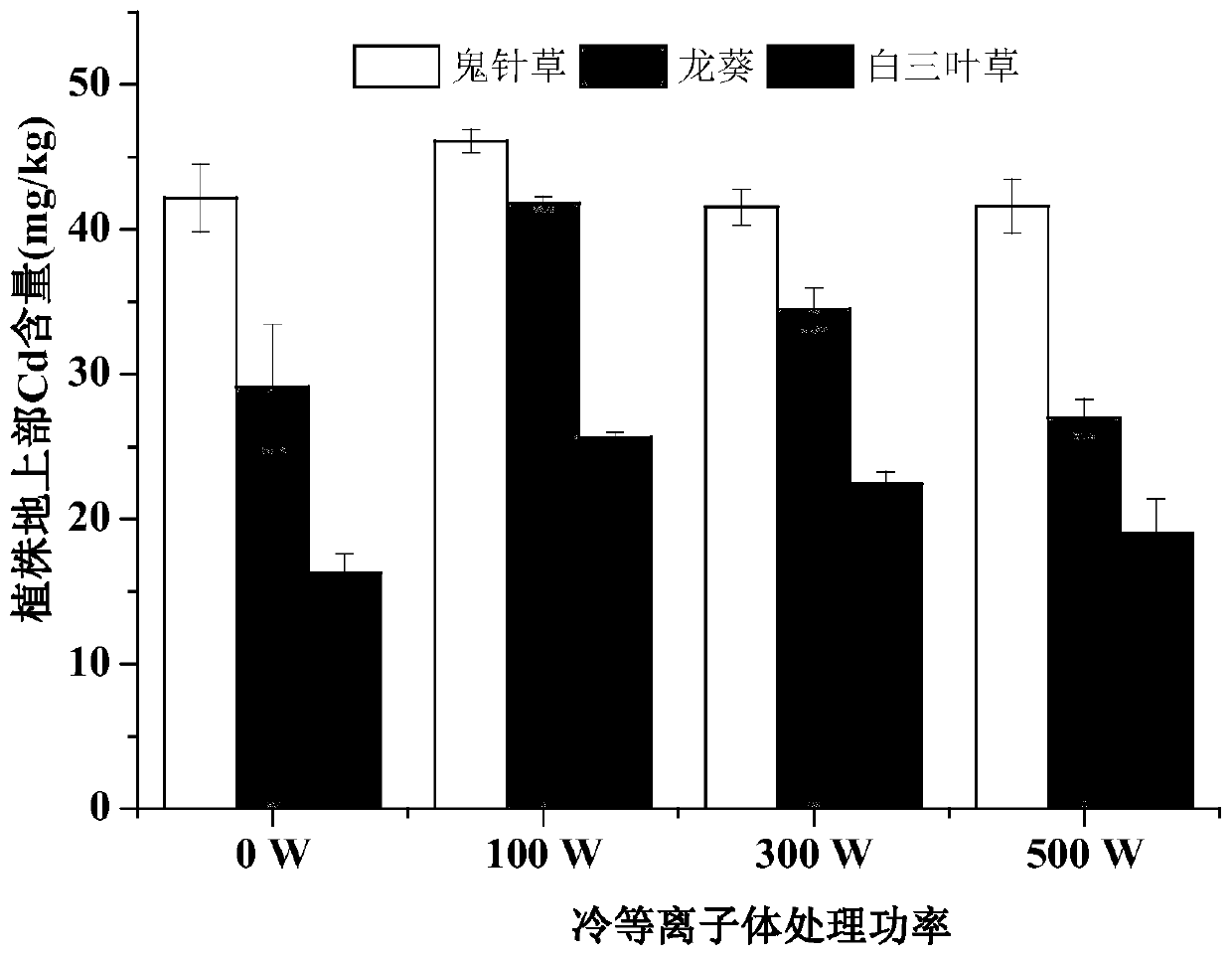Application of cold plasma seed treatment method in strengthening phytoremediation of cadmium contaminated soil
A cold plasma and seed treatment technology, applied in the restoration of polluted soil, seed and rhizome treatment, application and other directions, can solve the problems of low absorption efficiency of heavy metal Cd, weak accumulation and transfer ability, etc., and increase the enrichment coefficient. , the effect of improving the repair efficiency
- Summary
- Abstract
- Description
- Claims
- Application Information
AI Technical Summary
Problems solved by technology
Method used
Image
Examples
Embodiment 1
[0017] Solanum nigrum seeds were subjected to cold plasma treatment. First, put the seeds in the cold plasma seed treatment machine, and treat the seeds with non-ionizing radiation for 60s under the treatment power of 100, 300, and 500W, and at the same time, treat the seeds with the treatment power of 500w for 300s. ; The processing medium is air, and it is carried out in an environment with a vacuum degree of 2000pa. The treated seeds were tested in pots within one week, and non-plasma-treated seeds served as control treatments. The potting experiment area is located in the greenhouse of the Nanjing Soil Research Institute of the Chinese Academy of Sciences. The soil for the potting experiment was collected from a cadmium-contaminated farmland in Tongling City, Anhui Province. The basic physical and chemical properties of cadmium-contaminated farmland soil are pH 5.21, organic matter content 23.81g / kg, total nitrogen, total phosphorus and total potassium content are 0.89, 0...
Embodiment 2
[0022] The ghost needle grass seeds were subjected to cold plasma treatment. First, put the seeds in the cold plasma seed treatment machine, and treat the seeds with non-ionizing radiation for 60s under the treatment power of 100, 300, and 500W, and at the same time, treat the seeds with the treatment power of 500w for 300s. ; The processing medium is air, and it is carried out in an environment with a vacuum degree of 2000pa. The treated seeds were tested in pots within one week, and non-plasma-treated seeds served as control treatments. The potted experiment area, the test soil and the potted management measures are the same as in Example 1.
[0023]Compared with the control (CK) treatment without cold plasma treatment, although the Cd content in the plants of the plants treated with cold plasma seeds under different treatment conditions was not significantly increased (Table 2), but the suitable cold plasma The bulk treatment power significantly increased the enrichment c...
Embodiment 3
[0028] White clover seeds were subjected to cold plasma treatment. First, put the seeds in the cold plasma seed treatment machine, and treat the seeds with non-ionizing radiation for 60s under the treatment power of 100, 300, and 500W, and at the same time, treat the seeds with the treatment power of 500w for 300s. ; The processing medium is air, and it is carried out in an environment with a vacuum degree of 2000pa. The treated seeds were tested in pots within one week, and non-plasma-treated seeds served as control treatments. The potted experiment area, the test soil and the potted management measures are the same as in Example 1.
[0029] Compared with the control (CK) without cold plasma seed treatment, the white clover treated with 100W for 60s had a significant increase in the Cd content in the aboveground part of the plant, the ability to enrich and transfer Cd in the soil, and thus also significantly The remediation efficiency of white clover to soil Cd was greatly ...
PUM
 Login to View More
Login to View More Abstract
Description
Claims
Application Information
 Login to View More
Login to View More - R&D
- Intellectual Property
- Life Sciences
- Materials
- Tech Scout
- Unparalleled Data Quality
- Higher Quality Content
- 60% Fewer Hallucinations
Browse by: Latest US Patents, China's latest patents, Technical Efficacy Thesaurus, Application Domain, Technology Topic, Popular Technical Reports.
© 2025 PatSnap. All rights reserved.Legal|Privacy policy|Modern Slavery Act Transparency Statement|Sitemap|About US| Contact US: help@patsnap.com



